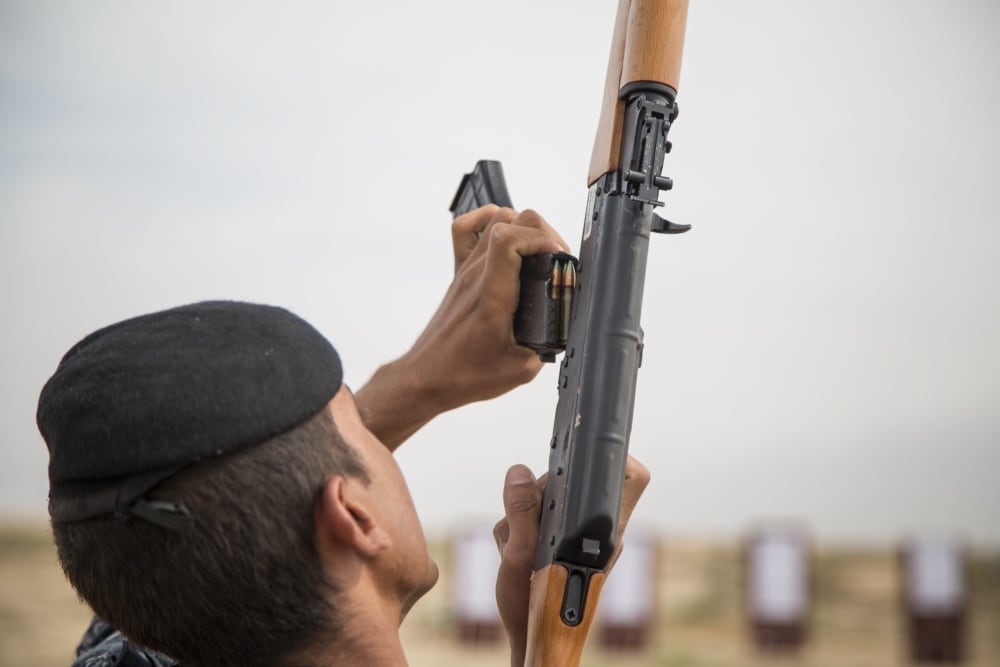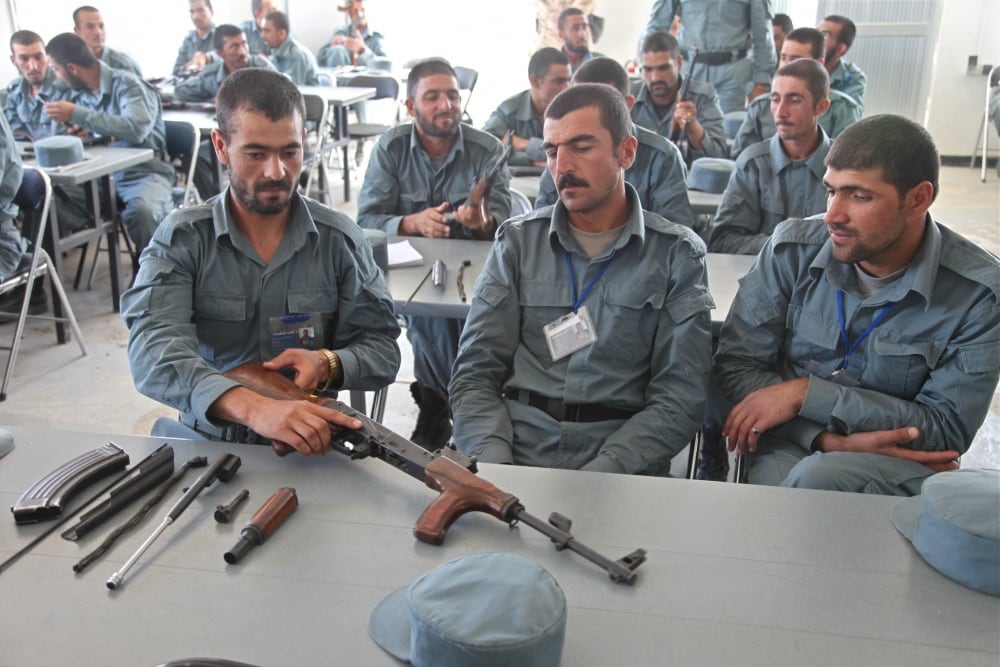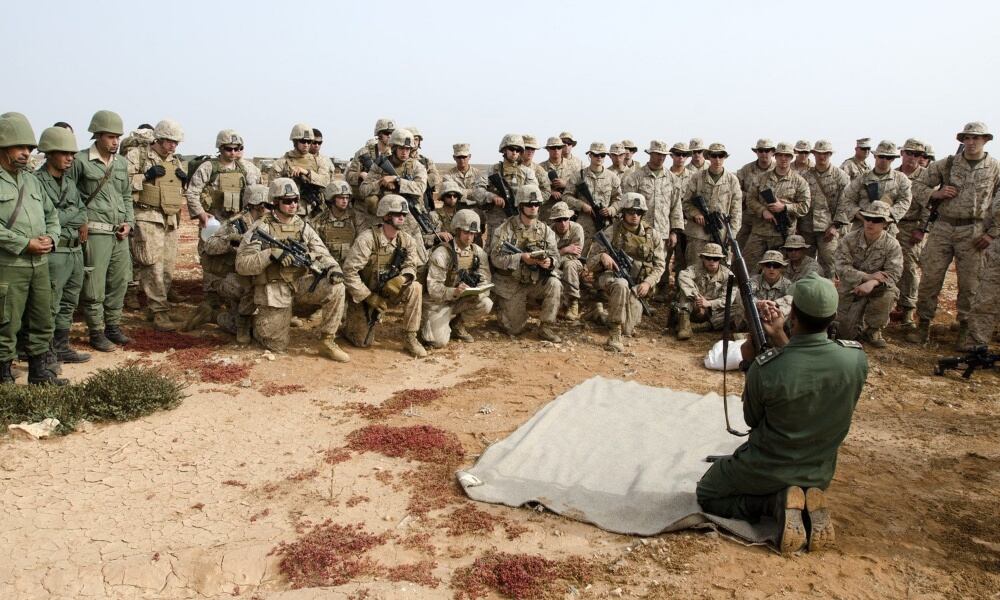Conceived as an intermediate rifle for Soviet foot soldiers, the AK became the prototype of the modern assault rifle.
A fine rifle has the same superbly machined beauty, purity and proportionate lines as does a complicated chronograph or a Ferrari V-12. Every detail is sharp and cleanly sculpted, and the metalwork is as close to perfect as tools can make it — burnished and blued, polished and shaped to perfection.
The AK-47 assault rifle, on the other hand, has all the aesthetic appeal of a toilet plunger.
Nobody intended the AK to be sold at Purdey & Sons or an Orvis outlet, and the AK’s supremacy in the pantheon of small arms has been assured by the fact that it also happens to have the same utility, durability and simplicity as a plumber’s helper — and that virtually any man, woman or child can operate it. Forget that this gun’s furniture (stock, grip, etc.) is often just a step above plywood, that the receiver is often stamped and riveted rather than forged and that its blunt configuration has more in common with a Super Soaker than something you’d expect a warrior to carry.
Read more from HistoryNet:
- Unbreakable: The Navajo Code
- Missing Alamo Missives
- Franklin’s Great Escape
- Lincoln’s Forgotten Defender
Despite — and due to — these qualities, the AK-47 today ranks as the deadliest, most prevalent and most game-changing individually wielded weapon in the history of military armament. Sadly, too, in the history of insurrection, revolution, coups, riots, sedition, anarchy, poaching, road rage, organized and unorganized crime and pointless killings of every sort.
Historians have recounted the “legend of the Kalashnikov” many times. So many times, in fact, that it has entered the realm of fairy tale. How senior sergeant and T-34 tank commander Mikhail Kalashnikov, wounded in battle in 1941, lay hospitalized. How he overheard his infantry bedmates griping about their ineffective rifles and began to visualize the design of an assault rifle better than the MP 40 submachine gun they’d witnessed the invading Germans use to deadly effect. How, after several tries, Kalashnikov came up with the ingenious gas-operated mechanism of the AK-47, despite being a superficially trained tinkerer with no gunsmithing experience. How Gen. Vasily Degtyarev, a famed Russian arms designer and Kalashnikov’s only real competitor in the shoot-off to decide the new standard assault rifle for the entire Soviet Army, graciously bowed out when he saw how good the sergeant’s design was. And, ultimately, how Kalashnikov never made a ruble from his unpatented invention.
We may never know the truth, as the fable of the lone NCO achieving greatness on behalf of the motherland answered the Soviet Union’s need for a proletarian hero. Kalashnikov was given a chest-busting panoply of medals, including two awards of the Hero of Socialist Labor, and was somehow promoted straight from sergeant to lieutenant general, albeit as an honorary rank.
Chances are Kalashnikov had some valuable initial insights, but a far more experienced team of gunsmiths likely did the sophisticated work of developing what became the AK-47 (Automatic Kalashnikov 1947). Indeed, he may have had little to do with the rest of the Kalashnikov family of guns, but the powers that be retained his name; Soviets and now Russians have always called the gun a “Kalash.” Kalashnikov himself, now 93, refuses to meet with interviewers who might pose embarrassing questions about his work.
The AK-47 begat a vast family of guns, many of which shooters casually refer to as “AKs.” Soviet arsenals produced the rifle in three similar yet distinct generations, each with its own offspring: the original AK-47, the AKM (AK Modernized, introduced into service in 1959) and the AK-74 (introduced into service in 1974). Most of the weapons the world today calls AK-47s are actually AKMs and their variants.

Ammunition played a central role in the success of what became the AK-47. Typical World War II–era infantry rifles, such as the classic U.S. M1 Garand or the long-barreled Soviet Mosin-Nagant, were designed to fire powerful single-shot rounds with substantial recoil but considerable range. Their bullets flew fast, flat and far, lethal at a distance of a kilometer or more. The cartridges were long and heavy, meaning a soldier couldn’t carry many into battle — certainly not enough to supply an automatic weapon that might blow through hundreds of rounds a minute — and they were expensive. The repeated recoil from such ammunition fired on a full-auto setting would have quickly shaken to pieces any firearm light enough for a single infantryman to carry. Submachine guns and pistols used short, low-load cartridges. Though dangerous at close range, none had the throw, accuracy or stopping power necessary in serious firefights.
Weapons designers proposed an “intermediate” round, a cartridge long enough to hold an amount of powder between long-rifle and pistol ammunition. Traditionalists didn’t buy it. “Why would you want a less powerful round?” they argued. Answers: because a soldier could carry twice as many rounds, the minimal recoil didn’t require a strong professional to handle it and who cared if it wouldn’t carry far enough to drop someone the shooter could barely see? The shooter probably wouldn’t be able to hit such a target anyway.
The Germans made effective use of intermediate rounds in the 7.92 mm MP 43/44. Adolf Hitler himself named the gun the Sturmgewehr (“storm rifle”). Historians widely regard it as the first modern assault rifle, a brand-new category of gun: a compact, short-barreled, selective-fire weapon with a high-capacity magazine that could be operated in either fully automatic mode or on semiautomatic — one round per trigger pull, but all cartridge loading and extracting done automatically. In automatic mode it had a rate of fire almost as fast as a true machine gun, yet a lone soldier could carry and operate it.
Without intermediate loads, the AK-47 would have been nothing more than a short-lived machine gun suitable only for briefly firing from the hip, like John Wayne with a belt-fed .30-cal in a 1940s war movie.
While the AK-47’s reasonable weight, comparative lack of recoil, intermediate rounds and compact size — a big plus for close-quarters urban warfare and other situations in which a long barrel gets in an infantryman’s way — were important qualities, what makes the weapon truly special is its simplicity and durability.
With as few as eight moving parts, depending on the version, an AK-47 can be field-stripped and reassembled by an illiterate 8-year-old Ugandan after less than an hour of training. The AK is often referred to as being “soldier-proof.” There’s virtually nothing a careless grunt, mujahideen, drive-by shooter, African child soldier or druglord bodyguard can do to break, harm or jam it. Drag it across a sandy desert, drop it in a muddy swamp, submerge it during a river crossing, forget to clean it for months at a time — no matter. The AK’s clearances and mechanisms are coarse enough that they shrug off filth that would instantly clog a more sophisticated weapon. Numerous reports tell of AKs found half-buried for months in a soggy Vietnamese jungle or abandoned in the Sinai sand that were ready to fire as soon as a boot kick freed the rusty bolt. (That its chamber and barrel are chrome-lined to prevent corrosion also helps.)

Soviet arms manufacture often seemed to bear out the aphorism “Perfection is the enemy of good enough.” The T-34 tank, MiG-15 fighter and AK-47 assault rifle are all examples of the need to create weapons “good enough” rather than wasting time on refinement and the pursuit of perfection. Each was designed and built quickly and in vast numbers. Quantity rather than quality was the byword, and in the case of the AK, such proliferation would lead to unintended consequences.
The AK has secured its place in firearms history not by its performance as a weapon of the conventional war for which it was designed — a Cold War that never turned hot enough to engulf the world’s two major superpowers in direct combat — but by its position as a purely military weapon that broke free of the fetters of armories and official control. It marked the first time this had happened with so sophisticated a military device, though some in the early 1930s had feared the Thompson submachine gun might find a broad civilian market. In those pre–gun lobby days, Congress in 1934 passed the National Firearms Act, which, among other measures, tightly regulated private ownership of automatic weapons.
The AK genie, however, escaped its bottle in the 1970s, both because it was cheap to manufacture and because it was produced in such enormous numbers. (Estimates place the number of functioning AKs in existence today at more than 75 million — vastly more than any other family of firearms ever produced.) Through the early postwar years, the AK was just another infantry firearm. It first appeared on the world stage in Vietnam, and its performance was a shock from a weapon Western experts had derided as puny, short-ranged and inaccurate.
U.S. troops in Vietnam had nothing like it, so the Army and Marine Corps rushed the new M16 assault rifle overseas. Initially, the M16 was a disaster. Unlike the AK, it needed to be scrupulously cleaned, but nobody had thought to provide the troops with cleaning kits. Nor were its barrel or chamber chrome-lined like those of the AK, so the early M16s quickly corroded. The M16 jammed constantly, and units found themselves in firefights with 30 to 40 percent of their American-made assault rifles useless against Viet Cong and North Vietnamese Army AK-47s.
Vietnam gave the Kalash credibility, and the Soviet Union’s 1979–89 war against Afghanistan — its very own Vietnam — opened the floodgates and released the weapon to the world. Unfortunately, the United States shares some of the blame for that.
The Afghan mujahideen feared the Soviets’ AKs because they fired slugs with thin casings over a cast-in airspace. Such bullets collapsed on impact with flesh or bone, carving out enormous wounds that quickly became infected. Convinced the Soviets were poisoning their bullets, the mujahideen begged their U.S. backers to supply them with such arms. Pakistan CIA Station Chief Howard Hart “finally relented and ordered hundreds of thousands of AKs, mainly from China,” writes Larry Kahaner in his comprehensive book AK-47: The Weapon That Changed the Face of War. “Hart’s decision … may have been the most important single contribution to the spread of the weapon.” Ultimately, the United States became one of the largest purchasers of AKs, handing them out in Iraq as well as Afghanistan.
The Soviet Union had long been giving AKs to Communist-bloc allies, as well as such friendly states as Cuba. Moscow also freely granted manufacturing rights, with no licensing fees, to a number of other countries. Freelance production inevitably followed, for the weapon is so simple it can be crafted in Middle Eastern bazaar workshops. Afghanistan, however, was the first time the weapon truly went rogue. The collapse of the Soviet Union then unlocked armory doors throughout the region, and it has been estimated that 80 percent of the Soviet Army’s small arms — most of them AKs — disappeared.

As AKs spread throughout Africa and Southeast Asia, particularly, they became self-sustaining. Rebel leaders like warlord Charles Taylor, who helped overthrow Liberian President Samuel Doe in 1990, recruited followers by offering them AKs with which to plunder and rape as well as killing for the cause, and the weapon became known as “the African credit card.” In Pakistan, suppliers reportedly rented AKs by the hour, and buyers would acquire them by posting a down payment and then using the weapon to rob someone for the balance due.
It is frequently claimed that in the Third World, well-used AKs are obtainable for the price of a live chicken — former United Nations Secretary General Kofi Annan once gave a speech announcing the guns were going for $15. Actually, from a typical low of about $150, used AK prices can run as high as $1,000, even more in times of great demand (e.g., civil war, narco-terrorism). In the United States a Chinese-made full-automatic AK can easily go for $10,000 on the black market, while semiautomatic versions (including many replicas, some built in North America) sell for $400 to $3,500, averaging about $1,500. Prices rise and fall in near-perfect sync with the state of chaos or calm in any turbulent country — and with the level of concern by American gun owners over proposed assault rifle bans.
The AK has become more than a weapon. In many countries and cultures, it is a symbol and a social statement in the same sense that a cowboy’s holstered Colt Peacemaker spoke volumes merely through its presence on his hip. The Kalashnikov is the most recognizable weapon in the world. Peruvian teenagers, aboriginal whale hunters, urban rappers, Somali warlords, Hutus and Tutsis, Sunnis and Shiites, Israelis and Palestinians, Diane Feinstein and Sarah Palin alike would identify a short-barreled weapon with a banana clip as “an AK-47.” When Hollywood wants to mark a character as a bad guy, they give him an AK, and the entire movie-going world gets it.
Though Saddam Hussein could have hoisted any gun in the world, he was never far from an AK-47, for it spoke for him. “I am an anti-imperialist — death to the West!” it said. So too for Osama bin Laden and his Kalash. In Afghanistan, an AK captured in combat from a Soviet soldier was vastly more valuable than one shipped in from China by the CIA. It was a symbol and then some — the 1980s version of counting coup or taking a scalp. As Gordon Rottman puts it in his brief but authoritative book The AK-47: “Throughout the world an individual’s act of swearing alliance to a regime, an insurgency, a warlord, drug lord or crime band was rewarded and solidified by bestowing an AK. … The AK-47 has become as much a symbol of the modern warrior as the bestowal of a spear, shield or headdress.”
The AK-47 and its derivatives deserve the title “Weapon of the Century,” at least in the early days of this epoch, because it is quite simply the most effective machine ever manufactured that allows a man, woman or child to kill another human being with the least possible skill, training, effort or expense. The Kalash has flourished, and today there are more AK models, accessories and upgrade parts to choose from than ever before. Since the working life of a well-used Kalashnikov weapon is a good quarter-century, and a gunsmith can rejuvenate or remanufacture one relatively simply, comrade Mikhail Kalashnikov’s contribution to world order should be with us a while longer.
This article was originally published in the September 2013 issue of Military History, a Military Times sister publication. For more information on Military History, and all of the History Net publications visit historynet.com.
